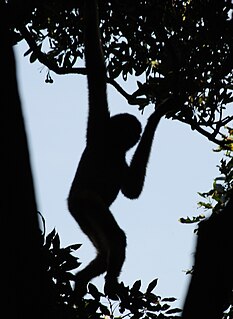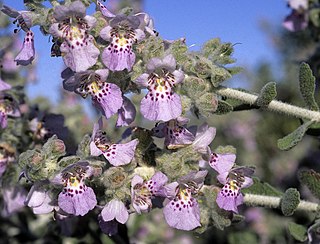
The Ericaceae are a family of flowering plants, commonly known as the heath or heather family, found most commonly in acid and infertile growing conditions. The family is large, with c. 4250 known species spread across 124 genera, making it the 14th most species-rich family of flowering plants. The many well known and economically important members of the Ericaceae include the cranberry, blueberry, huckleberry, rhododendron, and various common heaths and heathers.

Mentha is a genus of plants in the family Lamiaceae. The exact distinction between species is unclear; it is estimated that 13 to 24 species exist. Hybridization occurs naturally where some species' ranges overlap. Many hybrids and cultivars are known.

Gibbons are apes in the family Hylobatidae. The family historically contained one genus, but now is split into four extant genera and 18 species. Gibbons live in subtropical and tropical rainforest from eastern Bangladesh to Northeast India to southern China and Indonesia.

Apes are a branch of Old World tailless simians native to Africa and Southeast Asia. They are the sister group of the Old World monkeys, together forming the catarrhine clade. They are distinguished from other primates by a wider degree of freedom of motion at the shoulder joint as evolved by the influence of brachiation. In traditional and non-scientific use, the term "ape" excludes humans, and can include tailless primates taxonomically considered monkeys, and is thus not equivalent to the scientific taxon Hominoidea. There are two extant branches of the superfamily Hominoidea: the gibbons, or lesser apes; and the hominids, or great apes.

The Cyperaceae are a family of graminoid (grass-like), monocotyledonous flowering plants known as sedges. The family is large, with some 5,500 known species described in about 90 genera, the largest being the "true sedges" genus Carex with over 2,000 species.

The Loganiaceae are a family of flowering plants classified in order Gentianales. The family includes up to 13 genera, distributed around the world's tropics. There are not any great morphological characteristics to distinguish these taxa from others in the order Gentianales.

Prostanthera, commonly known as mintbush or mint bush, is a genus of about 100 species of flowering plants in the mint family Lamiaceae, and all are endemic to Australia. Plants are usually shrubs, rarely trees with leaves in opposite pairs. The flowers are arranged in panicles in the leaf axils or on the ends of branchlets. The sepals are joined at the base with two lobes. The petals are usually blue to purple or white, joined in a tube with two "lips", the lower lip with three lobes and the upper lip with two lobes or notched.

Commersonia is a genus of twenty-five species of flowering plants in the family Malvaceae. Plants in this genus are shrubs or trees, occurring from Indochina to Australia and have stems, leaves and flowers covered with star-like hairs. The leaves are simple, often with irregularly-toothed edges, the flowers bisexual with five sepals, five petals and five stamens and the fruit a capsule with five valves. The genus underwent a revision in 2011 and some species were separated from Commersonia, others were added from Rulingia.

Westringia is a genus of Australian shrubs. As with other members of the mint family their upper petal is divided into two lobes. There are four stamens - the upper two are fertile while the lower two are reduced to staminodes. The leaves are in whorls of 3 or 4.

The Hainan black-crested gibbon or Hainan gibbon, is a species of gibbon found only on Hainan Island, China. It was formerly considered a subspecies of the eastern black crested gibbon from Hòa Bình and Cao Bằng provinces of Vietnam and Jingxi County in Guangxi Zhuang Autonomous Region, China. Molecular data, together with morphology and call differences, suggest it is a separate species. Its habitat consists of broad-leaved forests and semi-deciduous monsoon forests. It feeds on ripe, sugar-rich fruit, such as figs and, at times, leaves, and insects.

Pityrodia is a genus of flowering plants in the mint family, Lamiaceae and is endemic to Australia, most species occurring in Western Australia, a few in the Northern Territory and one in Queensland. Plants in this genus are shrubs with five petals joined to form a tube-shaped flower with four stamens of unequal lengths.

Dasymalla is a genus of five species of flowering plants in the mint family, Lamiaceae and is endemic to Western Australia. Plants in this genus are woolly shrubs with five petals joined to form a tube-shaped flower with four stamens of unequal lengths. These species are similar to those in the genus Pityrodia except that the fruit does not release its seeds when mature.

Hemiphora is a genus of five species of flowering plants in the mint family, Lamiaceae and is endemic to Western Australia. Plants in this genus are woolly shrubs with warty, hairy leaves and with five petals joined to form a tube-shaped flower with four stamens. These species are similar to those in the genus Chloanthes in that the base of the leaves extends down the stem. They differ from Chloanthes, in that the leaves only extend a short distance down the stem.

Lachnostachys is a genus of flowering plants in the mint family, Lamiaceae, first described in 1842 by William Jackson Hooker. The type species is Lachnostachys ferruginea. The genus name, Lachnostachys, comes from two Greek words/roots, lachnề ("wool") and -stachys, and thus describes the genus as having spiked woolly inflorescences. The entire genus is endemic to Western Australia

Prostanthera prostantheroides is a plant in the family Lamiaceae and is endemic to Western Australia. It is a shrub with heart-shaped to round leaves and usually white flowers with purple spots inside the petal tube.

Quoya is a genus of flowering plants in family Lamiaceae and is endemic to Western Australia. Plants in this genus are shrubs with five petals joined to form a tube-shaped flower with four stamens of unequal lengths.

Muniria is a genus of four species of flowering plants in the mint family, Lamiaceae and is endemic to the Northern Territory in Australia. Plants in this genus are woolly shrubs with five petals joined to form a tube-shaped flower with four stamens of unequal lengths. These species are similar to those in the genus Pityrodia except that the branches are distinctly 4-angled in cross section and the fruit has calluses or ridges.
Quoya paniculata is a flowering plant in the mint family Lamiaceae and is endemic to Western Australia. It is a shrub with its branches and leaves densely covered with a layer of woolly hairs. The flowers are usually arranged in small groups surrounded by woolly hairs and are bell-shaped and deep purple or deep lilac. It is similar to Dasymalla axillaris and D. terminalis but is distinguished from them by its wedge-shaped leaf ends and more northerly distribution.
Barry John Conn, is an Australian botanist. He was awarded a Ph.D. from Adelaide University in 1982 for work on Prostanthera.

Mitreola sessilifolia, commonly known as swamp hornpod, is a species of small flowering plant in the genus Mitreola in the family Loganiaceae. The plant is native to the southeastern United States, but can be found as far west as Arizona. It was previously included in the genus Cynoctonum.It is also considered a facultative wetland species (FACW), which makes it an indicator species for wetlands, but may occur in non-wetland areas as well.

















